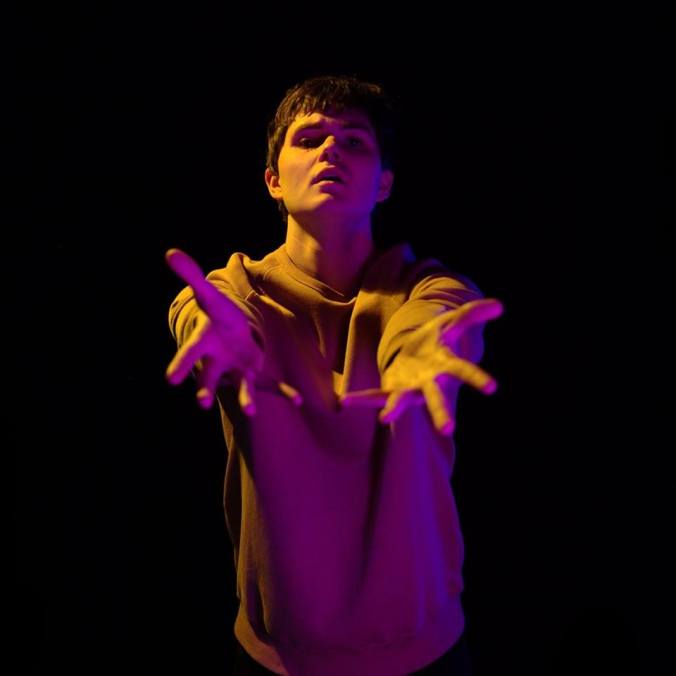
shown above: Kyle Reid Hass
Reviewed by Anthony Arcidi
The musical production team of Kyle Reid Hass and Jeremy Swanton may be nascent in the annals of musical theater, but their capabilities as playwrights and composers show promise despite the weaknesses of their first Off-Broadway production of Contact High: A New Musical at Theater 511 on West 54th Street. While the accomplishment of the pair is notable, the messages of drug addiction and school bullying never seem resolved or fully addressed with the seriousness the issues it deserves, due to numerous plot lines and elements making the characters less believable as typical high school students. The play’s intended audience is young adults and the composers most likely want them to identify with the characters.
The story opens with high school paramours Jean Simon, confidently played by Gabriella Marzetta, and Benjamin Crane, played by Swanton, conducting a heroin distribution ring to raise money for Benjamin’s expected tuition if he is accepted into Princeton. While a transaction of $20,000 is made to sound commonplace, the pair seem more at home in a street gangland environment than your typical classroom. These are not timid teenagers. Jean is a heroin addict in crisis who’s father is the gangland boss. Meanwhile the science club has decided to kick out Haley Walter Keys, played by Hass, a gentle giant boy in a tee-shirt and sweats who suffers from a mental disorder where he can become psychotic/psychopathic if he is touched without his permission. This is most likely because he is just not fitting in, despite his intellectual brilliance and the upcoming state science competition. The choice of a disability with violent repercussions could be problematic for any disabled viewer to feel comfortable with, since it supports an inherent bias against disabled people, stigmatizing them as dangerous landmines to be negotiated with rather than just being treated as normal folks with some physical or mental limitations. To top it off, there is intrigue about what happened to Tommy Wheeler, another student, who has disappeared and his whereabouts are unknown.
The friendship between Jean and Haley develops by breaking open a safe, in an implausible MacGyver-like fashion, to avenge Jean’s fouled drug transaction and raise money for Haley’s debt to a toughie, a developing mutual feeling of being outcasts and empathizing with Haley’s condition. The progression from Jean’s addiction to rehabilitation seems elusive and glossed over rather than addressed in any substantial way. Their triumph over being able to touch seems goofy and melodramatic, especially when Haley’s explanation of his disorder specified him being touched without his permission.
The 19 musical numbers are mostly a lighter catchy pop-rock style of performance with the basic choreography that the small stage can allow, along with the sad ballads for Jean’s heroin fixing scenes. The sense of angst ridden teenagers who question their future role in the world is conveyed, ranging from boldly singing “I am the future”, to “who will I be”, to, oddly, “there is no history”, and “maintaining the status quo.” The normal teenage attitude of distrust in authority comes through in the caricatured representation of the school staff and psychotherapist grief counselor, who is hiding a secret. The acted dialogue is dense in verbage, and many times is delivered in staccato fashion, sometimes rushing through the potential emotional impact of the lines. The pace of the plot development is not slow by any standards, but the number of plot strings muddles the focus on bullying and addiction recovery, especially when the ruthless mob boss, Landon Casey, an exaggerated caricature played by E.B. Hinnant takes the stage.
The set has the feel of a youth rec room with posters of the missing student Tommy Wheeler plastered everywhere along with newspaper pages surrounding the 25 foot square stage with six rolling chairs for staging. The music ensemble is visible at stage rear and left. Andrew Garvis’ competent stage lighting design changes from scene to scene and goes dark as cast members rearrange the characters’ movements. There is only one door for a stage entrance, and to make the most use of the small theater, the actors perform in the aisle several times for added spatial dimension.
Hass and Swanton, a noted recent graduate of the NYU Performance Studies Department, together developed Contact High from Hass’s high school screenplay titled The Science Fair. It turned into a workshop production at Theater Row’s Studio Theater as The Science Fair: A Game-Changing New Musical in 2017. This team has been spotlighted for their talent and I expect they will mature with each new production, which I look forward to seeing in the future.
Contact High runs August 15 through September 7, 2019 at Theater 511, West 54th street in Manhattan. http://www.contacthighmusical.com